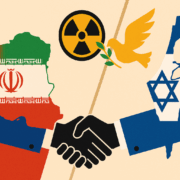Published: June 2025 – by Ralf
1 | Why This Matters Now
Missiles have already crossed borders, oil hovers near $150, and Tehran’s centrifuges keep spinning. Every hour without a structured off‑ramp narrows the Zone of Possible Agreement (ZOPA). Here’s what you must know -and what can still be done coming week to stop the slide toward regional war and beyond.
2 | Hard Facts: Iran’s Nuclear Threshold Talk
Ali Akbar Salehi: “All the Parts of the Car”
- Who? Former head of Iran’s Atomic Energy Organisation.
- What he said (11 Feb 2024): “We’ve crossed all scientific and technological thresholds… the chassis, engine, transmission -everything is in our hands.”
- Meaning: Iran admits it can assemble a bomb quickly -only 90 % enrichment and final assembly remain.
Javad Karimi Ghodousi: “One Week to Test”
- Who? IRGC veteran & senior MP.
- What he said (Apr 2024): If Khamenei gives the order, “we’d test the first bomb in a week… a warhead in half a day.”
- Reality check: Technically exaggerated, but credible enough to jolt markets and militaries; independent analysts put Iran’s breakout to weapons‑grade uranium at 1–2 weeks, warhead fabrication 6–12 months.
Bottom line: Tehran is loudly brandishing a deterrent‑in‑waiting. Ignore the bravado, but heed the capability.
3 | Why 60 % & 90 % Enrichment Rings Alarm Bells
- No power reactor needs it -commercial units run on <5 % U‑235; even new SMRs cap at 19.75 %.
- Civil niches are vanishing -research reactors and isotope producers are converting to ≤20 % under the HEU Minimisation Initiative.
- Strategic signal, not necessity -SIPRI: “Iran has no other realistic use for 60 % stock.”
Translation: Crossing 60 % is a short sprint -days, not months -to weapons‑grade.
4 | Immediate De‑escalation & Negotiation Blueprint
Strategic Objective
Freeze the fighting in 72 h, cap enrichment in 30 d, then craft a security bargain each side can sell at home.
Geneva–Muscat Tri‑Track
| Track | Goal | Core Parties | Neutral Host |
| A – Cease‑fire & Force Separation | Stop strikes; open hotline | Israel ↔ Iran (+ U.S.) | Switzerland / UN‑DPA |
| B – Nuclear Freeze & Verification | Enrichment ≤20 %, seal 60 % stock, full IAEA access | Iran ↔ P5+1 (ISR observer) | Oman / IAEA |
| C – Regional Security Basket | Missiles, maritime safety, Gaza/Lebanon spill‑over | GCC, Iraq, Jordan, Egypt, Turkey, EU, Russia, China | EU‑EEAS |
10‑Day Rapid Action Snapshot
- Day 0: UNSC 2894 -72 h truce; 150‑person UNMVI deployed.
- Day 1: IDF–IRGC hotline active; cross‑border strikes stop.
- Day 2: Iran freezes >20 % enrichment; U.S. issues 14‑day humanitarian waiver.
- Day 3‑4: Geneva deputy‑FM plenary drafts cease‑fire lines + nuclear cap.
- Day 7: “Provisional Framework” announced (≤20 % enrichment, Israeli strike halt, partial sanctions relief).
- Day 10: Verification protocol signed; first IAEA flash‑inspection scheduled.
Value Proposition
- Tehran: Keeps enrichment right; unlocks $6 bn humanitarian cash; ends deep‑strike threat.
- Jerusalem: Iran frozen below bomb threshold; self‑defence intact; quieter northern front.
- Washington: Avoids regional war & oil shock; contains Iran without troops; keeps allies aligned.
Enforcement Tools
- Snap‑back sanctions: Automatic unless 9/15 UNSC members block.
- “2 + 2 + 2” hotline: CENTCOM + IDF HQ ↔ Khatam‑al‑Anbia ↔ UNMVI.
- Joint Implementation Commission: Monthly in Geneva, chaired by UN Under‑SG.
5 | What Must Happen Tonight
- Deliver this concept to Swiss FDFA & Omani MFA -secure venues within 24 h.
- Convene virtual Track 1.5 “Geneva War Room” with retired Israeli & Iranian generals.
- Finish UNSC 2894 draft language; win Russian/Chinese yes‑vote by banning Israeli strikes on nuclear sites.
- Pre‑position WHO & ICRC aid -visible proof that diplomacy pays.
Sound‑bite for media: “Diplomacy buys 72 hours bombs can’t -enough time to save hundreds of lives and keep oil below $150.”
6 | Final Word
Every party’s BATNA is deteriorating by the hour. This blueprint keeps the door to compromise open -use it before it slams shut.
Hard Fact’s Deep-Dive Verification of –Iranian Officials’- Nuclear Weapon Capability Claims (Feb–Apr 2024)
Ali Akbar Salehi’s Statement: “All Components for a Bomb”
Ali Akbar Salehi – former head of the Atomic Energy Organization of Iran (and a past foreign minister) – gave an interview on Iranian state television in mid-February 2024 in which he made a striking assertion about Iran’s nuclear capabilities. Salehi stated that Iran has crossed “all the scientific and technological nuclear thresholds” needed to build a nuclear weapon, essentially claiming that Tehran now possesses every necessary component and know-how for a bomb. He offered a car-building analogy, explaining that Iran has “the chassis, the engine, the transmission, everything…in our hands,” implying the only thing Iran lacks is the final step of weapons-grade uranium enrichment and assembly. While Salehi stopped short of saying Iran will build a bomb, his remarks suggested Iran has achieved a nuclear “threshold state” status – i.e. it could produce a weapon on short order if it made the political decision to do so. Notably, Salehi’s comment marked a rare public admission by a senior Iranian figure that the country’s nuclear program has attained a point where weaponization is a viable option, despite official denials of any intent to pursue nuclear arms.
Salehi’s interview, aired on February 11, 2024 (on Iran’s Nasim TV), quickly drew international attention. Within days, International Atomic Energy Agency (IAEA) Director-General Rafael Grossi publicly warned that Iran’s recent “loose talk” about nuclear weapons is cause for serious concern, noting that a “very high official” (clearly referring to Salehi) had boasted that Iran has “everything…disassembled” to make a bomb. Grossi stressed that Iran was “not entirely transparent” about its nuclear activities and demanded evidence for Salehi’s claims: “Well, please let me know what you have,” he challenged. These remarks were made at a diplomatic summit in Dubai and underscored the alarm sparked by Salehi’s statement on the world stage. In Tehran, however, officials maintained that Salehi’s comments were misunderstood: Iran’s current atomic chief Mohammad Eslami reiterated that while Iran “has the capability” to build nuclear weapons, “we do not want to do it” as a matter of national security policy. This reflects Iran’s long-standing stance – often referencing Ayatollah Khamenei’s purported fatwa against nuclear arms – that it has restrained itself despite technological potential. Indeed, U.S. intelligence assessments have for years agreed that Iran has the technical capacity to make a bomb but has not taken a political decision to actualize a weapons program. In sum, Salehi’s February 2024 declaration (widely reported by outlets like Ynet, Fox/AP, and others) was genuine and signaled that Iran is now a nuclear-threshold state with all the needed components for a weapon – lacking only the final production of highly enriched (weapons-grade) uranium.
Javad Karimi Ghodousi’s Statement: “One Week to Test.. Half a Day to Build Warhead”
Roughly two months after Salehi’s remarks – amid rising regional tensions – an Iranian lawmaker made even more explicit claims about how quickly Iran could go nuclear. Mohammad Javad Karimi Ghodousi, a hardline member of Iran’s parliament (and its National Security and Foreign Policy Commission), took to X (Twitter) in April 2024 to signal Iran’s readiness for a nuclear weapons test. Ghodousi, a former Islamic Revolutionary Guard Corps officer, wrote that “if the Supreme Leader issues permission, we would be a week away from testing the first [nuclear bomb].”. In other words, he alleged that upon Ayatollah Khamenei’s order, Iran could detonate a nuclear device within seven days – a dramatic assertion for an official of his stature.
Just a day later, Ghodousi doubled down in a video message, claiming that even the warhead assembly would be almost instantaneous. He boasted that the IAEA is aware Iran “needs half a day or maximum a week to build a nuclear warhead.”. This extraordinary statement suggested that Iran’s weaponization process – from obtaining fissile material to an actual mounted warhead – could be completed in as little as 12 hours (perhaps an exaggeration to emphasize Iran’s efficiency). These comments were reported by multiple outlets and analysts; for example, Newsweek and think-tank experts noted Ghodousi’s claim that Iran could make a nuclear weapon “within days” and even extend its missile range dramatically if so instructed. Ghodousi’s pronouncements were unprecedented in their specificity and urgency, coming at a time when Iran-Israel hostilities had flared and Western intelligence was already warning of Iran’s shrinking breakout time. Indeed, his message aligned with warnings from an IRGC general (Ahmad Haghtalab) around the same time that Israeli military threats could force Iran to “review its nuclear doctrine” – hints that Iran might abandon its restraint under extreme duress.
Notably, the Iranian government moved quickly to contain the fallout from Ghodousi’s statements. The very same week, Foreign Ministry spokesman Nasser Kanaani reaffirmed that “nuclear weapons have no place in our defense and military strategy”. This was a direct response to the growing chatter about weaponization: Tehran’s official line insisted that Ghodousi’s provocative remarks did not reflect an actual policy shift. (Kanaani’s comments were reported in Iranian media and by Reuters on April 22, 2024.) The regime was effectively walking a fine line – allowing hardliners to signal a nuclear option for deterrence, while formally maintaining that Iran abides by its no-nuke doctrine. Such calibrated messaging was noted by Iranian observers; as one analyst wryly commented on social media, figures like General Haghtalab and MP Ghodousi were “assigned” to send a certain “pulse,” after which the Foreign Ministry performed its predictable denial – a choreography illustrating Iran’s nuanced approach to nuclear signaling.
Context, Credibility, and Implications for Iran’s Nuclear Program
The above statements – confirmed as authentic through credible sources including Iranian state TV broadcasts, Iranian officials’ social media, and reports by international media and think tanks – carry significant implications. They indicate that elements of Iran’s leadership are now openly advertising the country’s proximity to nuclear-weapons capability. For context, Iran’s rapid progress in uranium enrichment and weapons-relevant technology since the breakdown of the 2015 nuclear deal has drastically reduced the time needed to build a bomb. Independent assessments (e.g. the Institute for Science and International Security) found that as of early 2024, Iran could produce enough weapons-grade uranium for a bomb in as little as one week using a portion of its 60% enriched stockpile – a finding that aligns with Ghodousi’s swaggering claims. U.S. officials likewise warned that Iran’s “breakout” timeline (time to get fissile material) had shrunk to mere weeks. In that sense, Salehi’s and Ghodousi’s statements have a kernel of technical truth: Iran has amassed the knowledge, components, and enriched uranium stockpiles to be at the nuclear threshold. Even IAEA chief Grossi acknowledged late last year that Iran has “no longer any technical obstacles” to building a bomb, apart from the will to do so. The “all parts of a car” analogy used by Salehi neatly captures this reality. Furthermore, Tehran has developed advanced ballistic missiles that could serve as delivery systems, should a nuclear warhead be achieved, adding to the credence of its deterrent posturing.
However, experts urge caution in taking these boasts at face value. There is a difference between having the capability in principle and actually assembling a deliverable nuclear weapon in days. Western intelligence and nonproliferation analysts assess that while Iran could enrich uranium to 90% quickly, building a reliable nuclear warhead (especially one mountable on a missile) would likely take additional months of weaponization work. For example, the U.S. Defense Department estimated that after obtaining fissile material, Iran would still need 6–12 months to fashion an actual nuclear device that can be tested and weaponized. Ghodousi’s claim of “half a day” to assemble a warhead is widely viewed as hyperbole – perhaps meant to project overwhelming readiness, but not logistically realistic. Even countries with established programs cannot magically snap components together in a few hours without prior preparation. His “one week to nuclear test” assertion assumes Iran has a workable bomb design and maybe could conduct a simple underground test or a crude device on short notice. In reality, Iran has never tested a nuclear explosive, and doing so would be a major geopolitical step, likely detected by global monitoring. It’s more plausible that Iran could, in extremis, cobble together a rudimentary explosive device (for instance, a simple gun-type bomb that might not even require testing) relatively quickly – but deploying a compact warhead on a missile would be a far more complex endeavor. In short, the credibility of these statements is mixed: technically grounded in Iran’s demonstrated nuclear advancements, yet likely exaggerated in terms of speed and ease of actual weapon assembly.
International monitoring also factors into the credibility of Iran’s nuclear claims. Iran is still a party to the Nuclear Non-Proliferation Treaty (NPT) and under IAEA safeguards, though it curtailed enhanced inspections after 2018. The IAEA continues to report on Iran’s enriched uranium quantities and has detected traces of very high enrichment (up to 83.7% U-235) in Iran. If Iran tried to “dash” to a bomb, inspectors would probably detect the diversion of nuclear material, though as one report notes, Tehran could take steps to delay inspector access and exploit any gaps. The recent rhetoric from Tehran’s insiders may be aimed at leveraging Iran’s threshold status without actually crossing the line, in order to deter adversaries. Indeed, the timing of Salehi’s and Ghodousi’s remarks coincided with heightened Israel-Iran tensions (during the Gaza war and after reported Israeli covert strikes), suggesting these nuclear boasts were at least partly political signaling. Iranian officials like Kamal Kharrazi (a senior adviser) have openly warned that if Iran’s survival is threatened, it “will have no choice but to change [its] nuclear doctrine,” despite currently no decision to build the bomb. This conditional language reinforces that Iran is brandishing a deterrent-in-waiting – essentially telling the world that it can weaponize in short order if cornered, while still claiming restraint for now. The implications are profound: Iran’s adversaries must calculate that Iran could become a nuclear-armed state on very short notice, which could either deter attacks on Iran or, conversely, spur preemptive actions to stop its program.
In conclusion, the claims attributed to Salehi and Ghodousi were indeed made and have been documented by reliable sources (from Iranian state media to international news agencies and expert monitors). These statements underscore how far Iran’s nuclear capabilities have progressed and serve as strategic messaging. Iran now openly acknowledges being at the nuclear threshold – possessing the technology and components for a bomb – even as it maintains that it has chosen not to cross that final line. The international community, led by the IAEA and concerned governments, has taken these signals seriously, pressing Iran for transparency and caution. Ultimately, while Iran’s officials may exaggerate the speed of weaponization for effect, their core message is credible: Iran has never been closer to a nuclear weapon. This new rhetoric raises the stakes for nonproliferation efforts and heightens the urgency of diplomatic solutions to prevent a destabilizing sprint to an Iranian nuclear bomb.
Sources: Iranian state TV via Nasim Network (Feb 2024); Ynet News and AP reports (Feb 14, 2024); IAEA Director-General Grossi’s remarks; Arms Control Association (Arms Control Today, Mar 2024); Atlantic Council IranSource analysis (Apr 2024); Reuters (Apr 22, 2024); Iran International News (Apr 23, 2024); Institute for Science and International Security report (Feb 2024); Heritage Foundation report (Oct 2024); War on the Rocks (May 2024).
So why enrich all the way to 60 % or 90 % if you say you only want electricity?
- No power-reactor needs it. Every commercial light-water, heavy-water or gas-cooled reactor on the planet runs <5 % U-235 (CANDUs use natural uranium). Even Generation-IV and SMR designs that want “high-assay” fuel cap themselves at 19.75 %.
- The few real civilian niches above 20 % are shrinking fast. The United States, Russia, IAEA and the 99-state HEU Minimization Initiative have been converting research reactors and isotope production lines to ≤20 % for two decades.
- Experts therefore read 60 %+ enrichment as a strategic signal, not a necessity. SIPRI’s assessment of Iran’s 60 % stockpile put it bluntly: “Iran has no other realistic use for this material.” sipri.org
Bottom line
- Hard-fact non-weapons motives exist -naval reactors, legacy research reactors, some space or remote power concepts -but they occupy narrow, specialised corners of the nuclear landscape.
- None of them requires stopping at 60 %. If you can go to 60 %, the incremental effort to reach 90 % (actual weapons-grade) is measured in days for a modern centrifuge plant.
- That is exactly why the global norm is shifting to eliminate civilian HEU altogether and to keep even “exotic” peaceful applications below the 20 % threshold wherever technically possible.
If a country insists it needs 60 % or 90 % for “peaceful power generation,” the burden of proof is on it to show a credible naval, space-reactor or isotope-target programme that truly cannot work with ≤20 % fuel.
Otherwise, the high enrichment level looks -quite reasonably, like a hedge for indeed rapid weaponisation.
Immediate De‑escalation & Negotiation Blueprint: Every party’s BATNA is deteriorating daily
1. Strategic Objective
Stop regional escalation within 72 h, freeze Iran’s nuclear “dash” within 30 d, and open a durable path to a security bargain all three capitals can sell at home.
Failure means: Israeli saturation strikes, Iranian missile salvos, $150 oil, and unmanageable U.S. commitments.
2. Core Architecture – “Geneva‑Muscat Tri‑Track”
| Track | Participants | Immediate Purpose | Neutral Chair |
| A – Cease‑fire & Force Separation | Israel ↔ Iran (+ U.S.) | Halt strikes, activate hotline | Switzerland / UN‑DPA |
| B – Nuclear Freeze & Verification | Iran ↔ P5+1 (Israel observer) | Cap enrichment ≤20 %, seal 60 % stock, full IAEA re‑entry | Oman / IAEA |
| C – Regional Security Basket | GCC, Iraq, Jordan, Egypt, Turkey, EU, Russia, China | Missiles, maritime safety, Gaza & Lebanon spill‑over | EU‑EEAS |
3. 10‑Day Rapid Action Sequence (Snapshot)
Day 0 UNSC 2894 demands 72‑h truce & deploys 150‑person UNMVI team.
Day 1 IDF‑IRGC hotline activated via Swiss embassy; strikes stop outside national airspace.
Day 2 Tehran freezes enrichment >20 %; U.S. grants 14‑d humanitarian funds waiver.
Day 3‑4 Geneva deputy‑FM plenary starts drafting cease‑fire lines & nuclear cap parameters.
Day 7 Public “Provisional Framework” announced (enrichment ≤20 %; Israeli strike halt; U.S. partial sanctions relief).
Day 10 Verification protocol signed; UNMVI fully deployed; first IAEA flash‑inspection window locked in.
4. Value Proposition by Capital
- Tehran: Keeps enrichment right, unlocks medicines & frozen cash, ends Israeli deep‑strikes.
- Jerusalem: Freezes Iran at sub‑bomb threshold, maintains self‑defence, gains quiet front.
- Washington: Avoids regional war & oil shock, secures non‑nuclear Iran without boots, preserves coalition unity.
5. Enforcement & Safeguards
- Snap‑back clause: Any verified breach auto‑reimposes sanctions unless 9/15 UNSC members block.
- “2 + 2 + 2” Hotline: CENTCOM + IDF HQ ↔ Iran’s Khatam‑al‑Anbia ↔ UNMVI.
- Joint Implementation Commission: Monthly Geneva meetings; chairs UN Under‑SG.
6. Communication Hook
“Diplomacy buys 72 hours that bombs can’t and saves lives on both sides before the next missile closes the last window.”
Use ex‑generals, clerics and real deal cost‑of‑war data to push this framing in Hebrew, Farsi and English media.
7. Immediate Next Steps for Facilitators
- Deliver this concept note to Swiss FDFA & Omani MFA today; request venue readiness within 24 h.
- Convene virtual Track 1.5 “Geneva War Room” with retired Israeli & Iranian officials to stress‑test cease‑fire lines.
- Pre‑script UNSC 2894 language with EU partners; secure Russian/Chinese buy‑in by adding explicit bar on Israeli nuclear‑site strikes.
- Line‑up rapid humanitarian optics: WHO & ICRC packages ready to move the moment the framework is announced.
Remember: Every hour without a structured off‑ramp narrows the ZOPA. This blueprint keeps the door open.

 ImpactNegotiating.com
ImpactNegotiating.com ImpactNegotiating - 2025
ImpactNegotiating - 2025 ImpactNegotiating - 2025
ImpactNegotiating - 2025 ImpactNegotiating.com
ImpactNegotiating.com ImpactNegotiating 2025
ImpactNegotiating 2025 ImpactNegotiating-2025
ImpactNegotiating-2025 ImpactNegotiating.com
ImpactNegotiating.com
